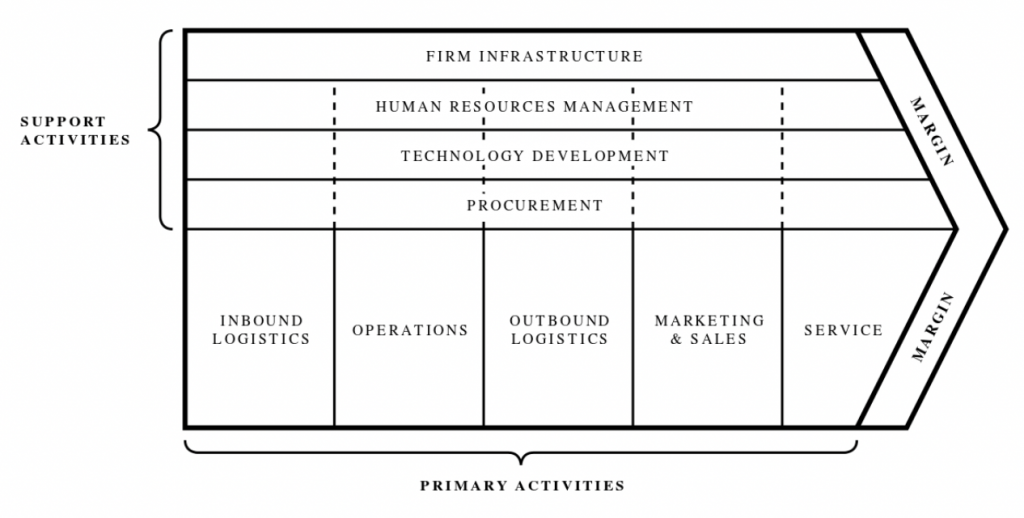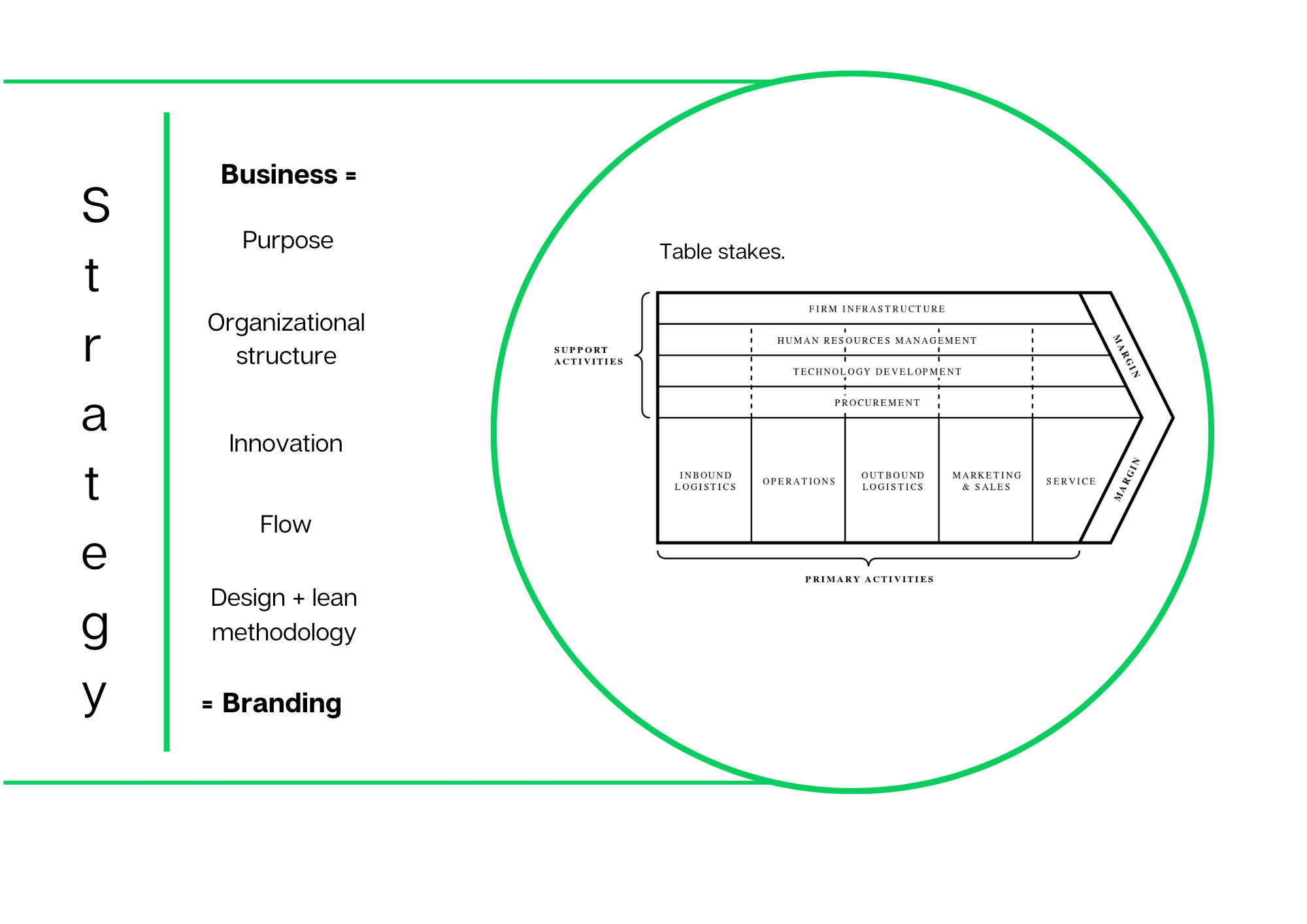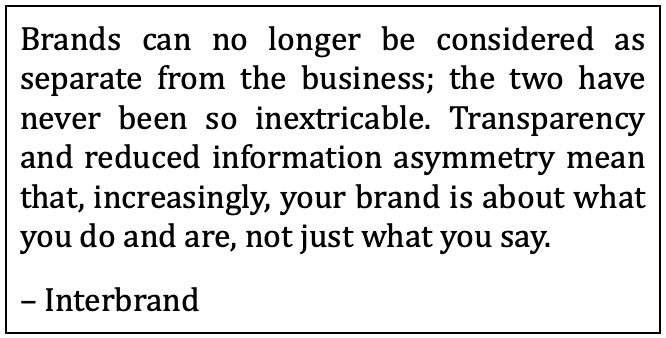Today more than ever, the brand has become a huge competitive asset. The values of top brands are being figured out into accountancy in the form of goodwill and intangible assets, and these evaluations are, in some cases, incredibly substantial. Brands can help you sell more products at higher prices, as well as shield you against the competition. A strong brand, however, is very hard to achieve. A big part of making branding difficult is played by an outdated and/or inadequate understanding of what brand and branding are. This article will shed light on this issue by considering what is a brand, and what is branding.
1. WHAT IS A BRAND?
Just about every consumer-facing company talks about brand. As do a good number of B2B oriented companies, too. Brand is something companies try to manage and direct. This is a natural approach, and there is nothing wrong with it as such. There are, however, considerable differences regarding the branding efforts between companies. Some are very successful, others not so much. While each company is unique and will have different challenges, there are lessons that can be abstracted and generalized for the benefit of everyone.
To proceed, we should briefly consider what brand is and is not. Today, most people working with brand will recite the correct answer: brand is not marketing, nor is it your company logo, a product, or your swanky HQ’s. Rather, brand is the feeling that others have of you. Indeed, it is not what you say it is. Money can’t buy you brand.
Does this mean brand is out of your control? Yes and no. And while the above is a good meta-level definition, it leaves a lot of questions open. What sort of department should we set up for brand, or is pursuing a brand futile if it is not something we can decide on ourselves?
What the above definition tells us is that brand is a result, not a strategy. Let’s look at what this means by way of analogy. Brand is often talked about as a person or personality (some people even have personal brands). This is done in order to drive the point as well as make it easier to imagine what others may think of your business.
So, you think of how we humans see other human beings. We would by and large agree that people are not what they say they are. Rather, what we think of other people is a combination of how we perceive their words, actions, and expressions of moods over time, as well as how we perceive an individual in relation to other people we know, or even in relation to stereotypes. Somebody may fancy themselves as a stand-up comedian, but when they get on the stage on open mic night, it may be we heartily disagree with what they are trying to tell us they are.
The way a person speaks and acts communicates to us at least some of their own aspirations and motives. Then, we interpret a person through our own lens by comparing them to a repository of our own experiences of other people and we place that person in a context.
Just the same way as a person, a company can go out and broadcast claims about itself. And so companies do – every company out there is making some claim towards their own excellence. Today, this is nothing more than a game opening. In this sea of almost identical grandiose promises, there is very little in terms of words that can differentiate one company from another.
The problem is that with the unprecedented access to information that the internet has brought with it, a democratization of knowledge has occurred. People have become more educated, critical, and aware concerning business and companies. Consequently, today it is harder for companies to woo consumers than it was in the past when it was harder for consumers to follow what companies were up to and they were more on the mercy of the messages companies were disseminating. Today, companies can expect more scrutiny as well as more direct consumer feedback.
Next, let’s jump into another analogy. Here we will consider what it means to say that brand is a result, not a strategy. Think about an athlete. The fact that one is an athlete (with a loose definition of an athlete being, say, belonging to the top end nationally in one’s discipline) is the outcome of a strategy which has organized hard work successfully in such a way which has led to the possibility to outperform the majority of other people in a given discipline as a result. Being an athlete is not a strategy – such a statement would indeed be meaningless, apart from perhaps individual pleasure such as when a child gleefully proclaims to be spider-man.
The point here is that an athlete is someone who has done what is necessary to positively differentiate their performance from that of their competitors. We find this person has been able to some extent control the image others have of them. They have earned the brand ‘athlete’ (although, of course, people may still evaluate them on other levels, such as are they an ‘aspirational’ person, a good role-model, or are do they behave questionably, etc. The point, however, is that they are recognized as an athlete).
We understand that every company has a brand, even if they do not try to build one. If a company does business, it will have customers. Those customers will form an opinion of the company they are dealing with. This is the brand of a company. Each and every company will get branded, like it or not. Consequently, when we speak about brand, what we are really referring to is differentiation. If your brand is boring and bland, through and through vanilla, then you don’t really have a brand
This does not mean you might not have a viable business. If your business plan is to reach the largest number of consumers possible through aggressive low pricing as a competitive strategy, you might do well without differentiating yourself too much. That way very few would feel strongly about you, including having a reason to dislike you, but a lot of people have a reason to use you (because you are the cheapest).
There is always a market for vanilla. It is just that there is not much room for competition in this market. It is all about scale and logistics, and that’s a hard race to the bottom. In this game there can only be one to maybe three winners and some survivors. The rest will have a hard time.
Finally, brand is an asset, or lack thereof. Brand valuations have placed the values of some of the best-known brands to be between 60-90% of the market capitalization of these companies. Brand also allows companies to set price premiums, and that way drive profits and achieve a healthy financial position.
2. WHAT IS BRANDING?
This is the verb – where it gets real. In short, branding is just doing it. We are going to illustrate this through the example of Nike.
Without going through the whole history, Nike began emerging in earnest towards the end of the ’80s. Back then, Nike was competing against sports shoe market leader Reebok. According to the analysis of the times, Nike succeeded because it just did it. Nike was aggressively pursuing the frontlines – it was seen worn by the top stars, and ads concentrated on the skin in the game (i.e. on the pursuit of being better, on fulfillment, on joy). New York Times, 1989:
”The advertising message has not been nearly as consistent” as Nike’s, said Dusty Kidd, editor of Sportstyle, a sports apparel and equipment trade journal. A series of Reebok ads last year that proclaimed ”Reeboks Let U.B.U.” was a case in point, Mr. Kidd added.
”It wasn’t clear what they were letting you be,” he said. ”Do you sell a performance shoe by showing an old woman in her back yard putting up her laundry? The message wasn’t clear.”
Nike’s advertising campaign, by contrast, has been widely praised for its artfulness and clarity. Nearly all the ads depict serious athletes engaged in sport. In a television ad, the basketball star Michael Jordan flies to the hoop in his Air Jordan shoes. In a famous billboard, an exhausted runner wearing Nikes stands drenched with water at the end of a race.”
It is said that “the “Just Do It” campaign allowed Nike to further increase its share of the North American domestic sport-shoe business from 18% to 43%, (from $877 million to $9.2 billion in worldwide sales) from 1988 to 1998.”
Today, this is stuff of legend, as attested to here by Marty Neumeier:
“As a weekend athlete, my two nagging doubts are that I might be congenitally lazy, and that I might have little actual ability. I’m not really worried about my shoes. But when the Nike folks say, “Just do it,” they’re peering into my soul. I begin to feel that, if they understand me that well, their shoes are probably pretty good. I’m then willing to join the tribe of Nike.” (The Brand Gap, 2006)
Yes, clever marketing absolutely did play a big part in the success of Nike. But no amount of clever marketing would have sufficed to elevate Nike to the status it holds were Nike not actually seen as just doing it. These were the guys who did not make excuses. They were there on the frontline, every time, all the time. This was not a campaign. This was what the company did. None of this came cheap. Where others would have been demanding guarantees over ROI before committing, Nike – say it with me – just did it. Nike took as its slogan a generalized definition of what it is to do something – the very essence of the term “brand” per se, fit for the Goddess of Victory herself. To be, or not to be? BE!
The Nike formula? Pragmatism + idealism = authenticity.
Where a lot of companies are pragmatic, they lack idealism. A business, in their view, is in the business of making money. Such a position can adequately be illustrated with Michael Porter’s value chain:

What underlies the formula of the above value chain is an ideology which sees the activities of a business as external or secondary to the business itself. Accordingly, the business itself is what these components (i.e. activities) support, and which are deducted from the business as costs.
Here the business itself consists of strategy and tactics (i.e. positioning). The aim of these is to steer the company and its activities in such a way as to make sense in relation to financial goals. A company that lacks idealism is wont to placing branding within the value chain. Whether branding was to be placed in as support activity or a primary activity is of little consequence. Placing branding in the value chain is by default not doing it.
Times have changed. Business itself has changed. Today, branding has publically entered the realm of what is considered as being the business itself – something a company like Nike was doing three decades ago. As opposed to the pragmatic business point of view, what is happening here is more like this:

This change from business driving strategy to strategy being the driver of business is the result of the democratization of knowledge. As it is harder for companies to influence consumers through an information asymmetry, strategy is no longer something static that companies execute. Instead, strategy today entails being fluid and following changing circumstances (VUCA).
As such, a strategy is not something a business imposes on its environment; rather, the strategy is a business accommodating its environment by adjusting to it. This results in crucial differences in how businesses are led.

In the above model we see that the underlying ideology has radically changed from the ideology which underlined the old model of value chains. Here, the business itself is led by the purpose of its activities for its customers as opposed to the purpose of competing at money making strategies where the role of business is to convert materials and labor into profits. In other words, the business of a company today is not to position itself (i.e. its brand) amidst the competition as if this was an activity made necessary by some external requirement made on the business itself. Instead of the business itself being detached from its position, it must now become the position.
What does it mean to become a position? It means to become authentic by adding idealism to pragmatism. Above we have talked about pragmatism. Now we move on to idealism. What we mean by idealism is a company’s mission, vision, values, and purpose. Let us have a look at what these are:
- Your mission describes what you do.
- Your vision paints a picture of what you want to achieve.
- Values are postulates that capture character states you consider to be inspirational and worthy of aspiring towards.
- Purpose considers the question of “why?”. “Why am I doing what I am doing”? To answer this question, it is necessary to consider the question “who am I?”.
3. AS A MATTER OF CONCLUSION
If a company is clear on all these points – which clarity is by no means easy to achieve – it becomes possible to lead with authenticity instead of trying to impose its own strategy of reacting by positioning. Authenticity is what then leads to what Interbrand calls “Iconic Moves”.
Therein lies the difference between an athlete and a weekend warrior. An athlete is seriously into their chosen pursuit, whereas a weekend warrior has all kinds of other things on their mind thereby diluting their purpose and vision. It shows. The weekend warrior will never be competitive in the field against athletes. Nike may tell us that everyone is an athlete. That’s nice of them. But – make no mistake – in their game very few are athletes. This is testified to by the number of really successful brands out there – very little in the sea of nondescript brands.
To become a position means not only to look at your mission, vision, values, and purpose. It means that you embody them. If you do not, you will not fare too well against someone who does. This means not looking at your business through the lens of an accountant (unless your business is in accountancy).
Branding is a result of pragmatic idealism turned into authenticity.
If you need help with you company’s branding efforts, check or services and contact us :)!

Comentarios recientes